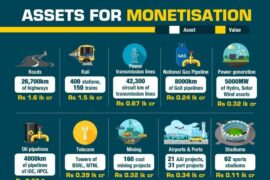Preamble
On 23 August 2021 the government announced a National Monetisation Pipeline of INR 6 tn, (~2.6% of GDP), aimed at monetising its brownfield infrastructure to fund greenfield ones. Most of these projects will be concentrated in the roads, railways, and power sectors and no monetisation of India’s healthcare assets. NMP provides the guide to funding the National Infrastructure Pipeline (NIP) announced by the Finance Minister on 31 December 2019. I had written an article on the NIP giving my observations and feedback on the NIP with respect to healthcare (see below).

Why is Healthcare Assets Monetisation not Under NMP?
It has been clearly apparent from the Covid 19 pandemic the clear shortages in the bed supply whenever there was a spike in the Covid cases. The private sector just did not have the capacity to manage the situation, burdening the Government and its healthcare resources to step up. I had warned about the gross under supply of beds in my critique to the NIP, “As per one of our investment thesis on healthcare infra in India, to meet the global norms of 3 beds per 1000 population India needs an investment of $200 billion by 2025. This is approximately the total NIP projected across all the infra sectors. The current NIP shows a committed pipeline of $2.5 billion which is only through Center and State Governments. A gap of 99% of what needs to be invested for India to meet global norms for healthcare infra supply! Unlike roads which is hogging over 80% of NIP’s committed investments, healthcare infra is gestational. Therefore, there is a weak and lagging healthcare infra investment in India leading to demand gaps.” These concerns that I had voiced have come out to be true during the Covid pandemic. The issue here is not about how much to invest in healthcare infrastructure but the issue of would the Government want a political turmoil now to sell off its healthcare assets out. More importantly, for the monetization of healthcare assets, there are other regulatory and tax issues for the Government to iron out to be ready for this sector’s assets to be monetized.
I believe that it has been a prudent move by the Government to exclude healthcare out from the NMP.
National Infra Pipeline (NIP) – Where is the Healthcare Infra Connectivity like Roads for the Masses? (Published in Jan 2020 in VC Circle)
Background
Over the last few months of 2019, the Government through various Ministries and industry bodies and Political Forum have tried to reach out to investors in healthcare infra to compile the pipeline of investments that are at various stages of implementation. This report was announced by the Finance Minster on 31 Dec 2019. We congratulate the Ministry of Finance in coming forward with the efforts in reaching out various stakeholders and sets the focus and discussions back on the economy.
While the report recognizes the fact that various mechanisms need to be put into place to debottleneck and fast track the investment process into infrastructure to meet our goals of a $5 trillion Indian economy by 2025 and be the second biggest economy in the world by 2050. It also recognizes the issues relating to land reforms, which the Government dropped out in earlier regime due to political opposition, financing, regulations amongst others. As India’s dedicated healthcare infra fund, we point out some of our observations and feedback on the report with respect to developing and funding healthcare infra in India.
Indian Healthcare Infra Economics
As per one of our investment thesis on healthcare infra in India, to meet the global norms of 3 beds per 1000 population India needs an investment of $200 billion by 2025. This is approximately the total NIP projected across all the infra sectors. The current NIP shows a committed pipeline of $2.5 billion which is only through Center and State Governments. A gap of 99% of what needs to be invested for India to meet global norms for healthcare infra supply! Unlike roads which is hogging over 80% of NIP’s committed investments, healthcare infra is gestational. Therefore, there is a weak and lagging healthcare infra investment in India leading to demand gaps.
While there is a further ripple effect of this investment on the wider economy in terms of job creation, healthy and productive population amongst others which we believe will be the second order issues that can be addressed as investment flows in. The key issue here is what measures the Government and Private Sector needs to take to accelerate the pace of investments and delivery of healthcare infra to the masses like road connectivity.
Key Policies and Measures to Attract and Boost Healthcare Infra Investments from Private Sector
GST Bottlenecks on Input Side with No Pass Thrus on Output Side
Any healthcare infra investments structure whether PPP or private with asset-lite models is taxed under GST. While there is no scope for pass thrus of these costs on the output side. Several representations to the Government on correcting this anomaly have been presented at the highest levels. Unless this is corrected, private sector participation investment is only a minor aggregate to the investments.
Interest Rates YoYo Regime
RBI in its efforts to contain the inflation has not directionally provided a proper guidance of interest rates over the last few years. These changes in interest rates are difficult to model and predict for our investors both Indian and foreign. Healthcare infra investments require a stable interest rates regime.
Bank Leverage for Healthcare Infra
Over the last few years of liquidity crisis with the banking sector, healthcare infra financing like other infra financing has been deprioritized by the banking system as a whole as very high risk. Our discussions with senior leadership with various top banks does not give any confidence that the worst is over for the healthcare infra sector bank financing with many still negative with the burden of NPAs of the past. A policy to establish healthcare infra as a priority sector for bank would be in positive direction.
Pivoting Infra Models for Delivery of Ayushman Bharat
Ayushman Bharat is a positive step in Nation’s healthcare financing and delivery. However, the last report of Niti Aayug states that around 90% of all players in India owning healthcare infra employ less than 10 employees! Seriously, are these really hospitals delivering quality care? Given the current reimbursement rates, private sector participation in the whole scheme can only be marginal or absent in their current healthcare infra operating cost base. A more innovative low-cost infra investment model needs to be developed which some players are working towards to pivot towards the requirements of Ayushman Bharat.
Monetising Existing Gun Powder of Healthcare Infra
There is an approximately $45 billion of healthcare infra assets which are sitting on the books of Central and State Governments and Private and Social Sectors. Many of these require funding for upgrading and expanding their infra. Various archaic regulations and other operations bottlenecks are preventing investments flows into these existing healthcare infra from Indian and foreign investors.
Nine Men Cannot Produce a Baby in a Month (even in a test tube)
While healthcare infra is a highly gestational business, it is dependent on supply of adequate clinical and operational manpower from the investments in the education sector. The NIP duplicates the investments in AIIMs under health and education. A similar push is required in the education sector for private sector participation.
Social Stock Exchange – A Black Swan for Healthcare Social Infra
While working on the regulations for the Social Stock Exchange (SSE) with SEBI. There are several regulations that govern the social sector in terms of ownership of land and infra that need to be streamlined for a healthy investments in social health infra. We estimate that the addressable social ventures that would qualify to be listed on the SSE would potentially deliver an annual turnover to be around $5 bn on a conservative basis from various impact investors. If the regulations are streamlined, our expectations is that this would be increased by a multiple of 3X.
In Conclusion – Our Forward Looking and Safe Harbour Statements
While the NIP is a great exercise for setting the vision and strategy for the way forward. We believe that investor confidence is still muted and the dialogue between the Government and Healthcare Infra Investors and Operators need to be urgently set up for strategizing how the current estimates in NIP for healthcare infra can be boosted 100X to meet the current deficit to Healthcare Infra Connectivity like Roads for the Masses to meet the global norms.

